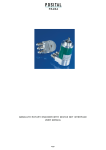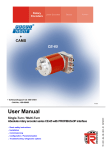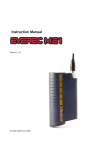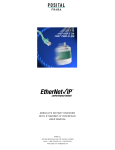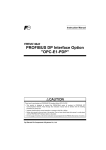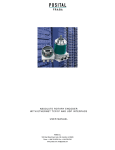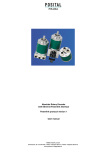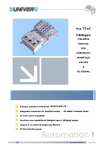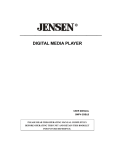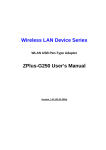Download absolute rotary encoder with device net interface user manual
Transcript
ABSOLUTE ROTARY ENCO DER W ITH DEVICE NET INTERFACE USER MANUAL FRABA Inc. 1800 East State Street, Suite 148, Hamilton, NJ 08609 Phone +1 609 750 8705, Fax. +1 609 750 8703 www.posital.com, [email protected] DEVI CENET USER MANUAL Imprint Disclaimer of Warranty FRABA Inc. FRABA POSITAL GmbH makes no representations or warranties, either express or implied, by 1800 East State Street, Suite 148 or with respect to anything in this manual. And shall not be liable for any implied warranties of Hamilton, NJ 08609 USA Phone +1 609 750 8705 merchantability and fitness for a particular purpose or for any indirect, special, or consequential Fax. damages. +1 609 750 8703 www.posital.com [email protected] Document information File name: UMUS-OCD-D.doc Copyright Versionnumber: 05/09 Author: KMA/EIO The company FRABA POSITAL GmbH claims copyright on this documentation. It is not allowed Phone Service to modify, extend, copy, or hand over to a third party this documentation without written approval For technical support, questions and suggestions for improving our products and documentations by the company FRABA POSITAL GmbH .Nor is any liability assumed for damages resulting from call our telephone line +49 (0) 221-96213-0. the use of the information contained herein. Further, this publication and features described herein are subject to change without notice. Alteration of Specifications reserved Technical specifications, which are described in this manual, are subject to change due to our permanent strive to improve our products. Version 05/09 Page 2 UMUS-OCD-D2_05_09.doc DEVI CENET USER MANUAL 1. Introduction ..................................................... 4 1.1 Control and Information Protocol (CIP) ............ 5 1.2 Object modell ................................................... 6 2. Data Transmission .......................................... 7 2.1. The Object Dictionary...................................... 7 2.2 Definition of the CAN-ID ................................... 8 3. Programmable Parameters ............................ 9 3.1. Encoder parameters ....................................... 9 3.1.2. Resolution per revolution ............................. 9 3.1.5. MAC-ID ...................................................... 11 3.1.6. Baudrate .................................................... 11 4. Operating Mode ............................................. 12 4.1. Polled Mode .................................................. 12 4.2. Change of State Mode .................................. 14 4.3. Saving Parameter ......................................... 15 5. Transmission of the actual position ............ 15 6. Installation ..................................................... 16 6.1. Electrical connection ..................................... 16 6.2. Setting of the baudrate .................................. 17 6.3 Cabel.............................................................. 17 6.3 Connector ...................................................... 17 7. Power On ....................................................... 18 7.1. Operating Mode ............................................ 18 7.2. Programming ................................................ 18 7.2.1. Operating Parameter.................................. 18 7.2.3. Total resolution .......................................... 19 7.2.4. Preset Value .............................................. 20 7.2.5. MAC-ID ...................................................... 21 7.2.6. Baudrate .................................................... 21 8. RsNetworx ..................................................... 22 8.1. EDS Wizard .................................................. 22 8.2 Driver Configuration ....................................... 24 8.3 Network Connection ....................................... 26 Version 05/09 Page 3 UMUS-OCD-D2_05_09.doc DEVI CENET USER MANUAL 1. Introduction Absolute rotary encoders provide a definite value The integrated CAN-Bus interface of the absolute for every possible position. All these values are reflected on one or more code discs. The beams of rotary encoder supports all of the DeviceNet functions. The following modes can be programmed and infrared LEDs are sent through code discs and detected by Opto-Arrays. The output signals are enabled or disabled: Polled Mode electronically amplified and the resulting value is transferred to the interface. Change of State The protocol supports the programming of the fol- The absolute rotary encoder has a maximum reso- lowing additional functions: Code sequence (Complement) lution of 65536 steps per revolution (16 Bit). The Multi-Turn version can detect up to 16384 revolu- Resolution per revolution Total resolution tions (14 Bit). Therefore the largest resulting resolution is 30 Bit = 1.073.741.824 steps. The standard Preset value Baudrate Single-Turn version has 12 Bit, the standard MultiTurn version 24 Bit. MAC-ID The general use of absolute rotary encoders with DeviceNet interface is guaranteed. Version 05/09 Page 4 UMUS-OCD-D2_05_09.doc DEVI CENET USER MANUAL 1.1 Control and Information Protocol (CIP) The DeviceNet specification defines the Application Layer and the Physical Layer. The Data Link layer CIP (Common Industrial Protocol) make for the user available four essential functions: is based on the CAN-specification. For the optimal industrial control will be defined two different mes- • Unique control service saging types. I/O messaging (Implicit Messaging ) and explicit messaging.With Implicit Messaging • • Unique communication service Unique allocation of messaging becoming I/O data exchanged in realtime and with Explicit Messaging becoming data exchanged to • Common knowledge base configure a device. Version 05/09 Page 5 UMUS-OCD-D2_05_09.doc DEVI CENET USER MANUAL 1.2 Object modell DeviceNet describes all data and functions of a device considering as object model. By means of that object-oriented description a device can be defined complete with single objects. A object is defined across the centralization by associated attributes (e.g. processdata), his functions (read- or write access of a single attribute) as well as by the defined behaviour. DeviceNet distinction is drawn between three different objects: • Communication object Define the exchange messages over DeviceNet and becoming designated as Connection Objects. (DeviceNet Object, Message Router Object, Connection Object, Acknowledge Handler Object) • System objects Define common DeviceNet-specific data and functions. (Identity Object, Parameter Object) • Applications-specific objects Define device-specific data and functions. (Application Object, Assembly Object) Version 05/09 Page 6 UMUS-OCD-D2_05_09.doc DEVI CENET USER MANUAL 2. Data Transmission The data transmission in the DeviceNet network is CAN-ID Message Header Message Body realised by message telegrams. Basically, these telegrams can be divided into the CAN-ID and 8 11 Bit 1 Byte 7 Byte following bytes as shown in the table below: 2.1. The Object Dictionary Instance Attribute of the Position Sensor Objects Class Code: 23 hex Attribute ID Access Name Data Type Description 1 hex Get Number of Attributes USINT Number of supported Attributes 2 hex Get Attribute Array of USINT List of supported Attribute 3 hex Get Position value DINT current position 0B hex Get / Set Code sequence Boolean Controls the code sequence clockwise or counterclockwise 2C hex Get / Set resolution per revolution INT resolution for one revolution 2D hex Get / Set total resolution DINT total measurable resolution 2E hex Get / Set preset value DINT setting a defined position value 6E hex Get / Set Baudrate Adjustment of the Baudrate 6F hex Get / Set MAC ID Adjustment of the MAC ID Get / Set: Version 05/09 : read, write Page 7 UMUS-OCD-D2_05_09.doc DEVI CENET USER MANUAL 2.2 Definition of the CAN-ID DeviceNet is based on the standard CAN-protocol and used a 11Bit (2048 specifiable messages) the Message Group, Message ID and the MAC ID of the device. messages identifier. For the identification of a device in a DeviceNet network are 6Bit enough By our absolute rotary encoder it is a matter of a Group 2 Messages. In the table below a user can because a network belongs 64 nodes. That nodes will be call MAC-ID. The CAN-Identifier consists of see the importance communication type. CAN-IDs for a certain . 10 9 0 8 7 6 Group 1 5 4 3 2 1 0 Identity Usage Hex Range Source MAC ID GROUP 1 Message 000-3ff Message ID 0 1 1 0 1 Source MAC ID Slave’s I/O Change of State or Cyclic Message 0 1 1 1 1 Source MAC ID Slave’s I/O Poll Response or Change of State/Cyclic Acknowledge Message 1 0 MAC ID Group 2 GROUP 2 Messages 400 - 5ff Message ID 1 0 Destination MAC 0 1 0 ID Master’s Change of State or Cyclic Acknowledge Message 1 0 Source MAC ID 1 0 Destination 0 1 1 Slave’s Explicit/Unconnected Response Messages MAC 1 0 0 Master’s Explicit Request Message 1 0 MAC 1 0 1 Master’s I/O Poll Command/Change of State/Cyclic 1 0 Destination ID MAC 1 1 0 Group 2 Only Unconnected Explicit Request Message (reserved) 1 0 Destination ID MAC 1 1 1 Duplicate MAC ID Check Messages ID Destination ID Version 05/09 Message Page 8 UMUS-OCD-D2_05_09.doc DEVI CENET USER MANUAL 3. Programmable Parameters 3.1. Encoder parameters 3.1.1. Operating Parameter The operating parameter can be used to select the code sequence. Attribute ID Default value Value range Data Type 0 b hex 1 hex 0 hex - 1hex Boolean The parameter code sequence (complement) defines the counting direction of the process value as seen on the shaft whether clockwise or counter clockwise. The counting direction is defined in the attribute 0b hex: Bit 0 Drehrichtung Ausgabecode 1 CW Steigend 0 CCW Fallend 3.1.2. Resolution per revolution The parameter resolution per revolution is used to program the encoder to set a desired number of steps per revolution. Each value between 1 and the maximum (see type shield) can be realised Attribute ID Default value Value range Data Type 2C hex (*) 0hex - 2000hex Unsigned Integer16 (*) see type shield, Maximum resolution: 12/24 Bit Encoder: 1,000 hex (4096) 13/25 Bit Encoder: 2,000 hex (8192) When the value is set larger than 4096 (8192 for a skipped while rotating the shaft. So, it is recom- 13/25 Bit encoder), the process value of the encoder will not be single stepped and values will be mended, to keep the measuring steps per revolution below 4096 (8192) measuring steps. Version 05/09 Page 9 UMUS-OCD-D2_05_09.doc DEVI CENET USER MANUAL 3.1.3. Total resolution This value is used to program the desired number (25 bit = 33,554,432 steps). Please note the value of measuring steps over the total measuring range. This value must not exceed the total resolution of written on the type shield. the encoder with 24 bit = 16,777,216 steps Attribute ID Default value Value range Data Type 2D hex (*) 0h - 2,000,000h Unsigned Integer 32 (*) see type shield Maximum total resolution 24 Bit Encoder: 1,000,000 hex 25 Bit Encoder: 2,000,000 hex Attention: The following formula letters will be used: - PGA Physical total resolution of the encoder (see type shield) - PAU Physical resolution per revolution (see type shield) - GA AU Total resolution (customer parameter) Resolution per revolution (customer parameter) If the desired resolution per revolution is less than the physical resolution per revolution of the encoder, then the total resolution must be entered as follows: Total resolution GA = PGA * AU / PAU, if AU < PAU Example: Customer requirement: AU = 2048, Encoder type shield: PGA=24 bit, PAU=12 bit GA = 16777216 * 2048 / 4096 GA = 8388608 If the total resolution of the encoder is less than the physical total resolution, the parameter total resolution must be a multiple of the physical total resolution: - k = PGA / GA k = integer 3.1.4. Preset value The preset value is the desired position value, which should be reached at a certain physical position of the axis. The position value of the encoder is set to the desired process value by the parameter preset. The preset value must not exceed the parameter total measuring units Attribute ID Default value Value range Data Type 2E hex 0 hex 0hex - total measuring range Unsigned Integer 32 Version 05/09 Page 10 UMUS-OCD-D2_05_09.doc DEVI CENET USER MANUAL 3.1.5. MAC-ID Attribute ID Default value Value range Data length 6F hex 0 hex 0hex – 3Fhex BYTE Each node in a Device Net network is identified A Device Net netwok supports 64 nedoes. The using a MAC-ID (Media Access Control Identifier). Every device needs an explicit and unique MAC-ID. MAC-ID can only be adjusted via explicit messaging. The default MAC-ID is setting on d63. 3.1.6. Baudrate Attribute ID Default value Value range Data length 6E hex 0 hex 0hex - 2hex BYTE Device Net supports three different baurates that that the selective baudrate has to be the same as are being showed in the below table. The baudrate can be changed via explicit messages and stored in the Device Net network baudrate. The default baudrate is setting 125kBaud. the EEPROM with a save command. It is to insure 0x Baudrate in kBaud 0 125 1 250 2 500 Version 05/09 Page 11 UMUS-OCD-D2_05_09.doc DEVI CENET USER MANUAL 4. Operating Mode 4.1. Polled Mode For switching the polled mode on the following following example a master MAC ID of 0A hex and telegrams are needed. Further it is assumed in the a slave MAC ID of 03 hex. Allocate Master / Slave Connection Set 1. Allocate Polling Byte Offset Bit 7 Bit 6 Bit 5 Bit 4 0 Frag [0] XID MAC ID 1 R/R [0] Service [4B] Bit 3 Bit 2 Bit 1 Bit 0 Class ID [03] Instance ID [01] Allocation Choice [03] 0 0 Allocator MAC ID Definition CAN ID 10 9 8 7 6 5 4 3 2 1 0 Identity Usage 1 0 Destination MAC 1 1 0 Group ID Hex Range 2 Only Unconnected Explicit Request Message (reserved) Example: CAN-ID Byte 0 Byte 1 Byte 2 Byte 3 Byte 4 Byte 5 41E 0A 4B 03 01 03 0A 1. Setting the Expected_packet_rate of the Explicit Message Connection on 0: Definition CAN-ID 10 9 8 7 6 5 4 3 2 1 0 Identity Usage Hex Range 1 0 Destination MAC 1 0 0 Master´s Explicit Request Message ID Version 05/09 Page 12 UMUS-OCD-D2_05_09.doc DEVI CENET USER MANUAL Example: CAN-ID Byte 0 Byte 1 Byte 2 Byte 3 Byte 4 Byte 5 Byte 6 41C 0A 10 05 01 09 00 00 1. Setting the Expected_packet_rate of the Polling Connection on 0:n: Example: CAN-ID Byte 0 Byte 1 Byte 2 Byte 3 Byte 4 Byte 5 Byte 6 41C 0A 10 05 02 09 00 00 Release Master / Slave Connection Set Release Polling Byte Offset Bit 7 Bit 6 Bit 5 0 Frag [0] XID MAC ID 1 R/R [0] Service [4C] Bit 4 Bit 3 Bit 2 Bit 1 Bit 0 Class ID [03] Instance ID [01] Release Choice [03] Example: CAN-ID 41E Version 05/09 Byte 0 Byte 1 Byte 2 Byte 3 Byte 4 0A 4C 03 01 03 Page 13 UMUS-OCD-D2_05_09.doc DEVI CENET USER MANUAL 4.2. Change of State Mode The absolute rotary encoder sends data, without position value is not changing. This results in a any request from the host, when the actual process value is changing. No telegram will occur when the reduced bus loading. Allocate Master / Slave Connection Set Allocate COS Byte Offset Bit 7 Bit 6 Bit 5 Bit 4 0 Frag [0] XID MAC ID 1 R/R [0] Service [4B] Bit 3 Bit 2 Bit 1 Bit 0 Class ID [03] Instance ID [01] Allocation Choice [51] 0 Example: CAN-ID 41E 0 Allocator MAC ID Byte 0 Byte 1 Byte 2 Byte 3 Byte 4 Byte 5 0A 4B 03 01 51 0A 2. Setting Expected_packet_rate of the Explicit Message Connection on 0: Example: CAN-ID Byte 0 Byte 1 Byte 2 Byte 3 Byte 4 Byte 5 Byte 6 41C 0A 10 05 01 09 00 00 3. Setting Expected_packet_rate of the Change of State Connection on 0: Example: CAN-ID Byte 0 Byte 1 Byte 2 Byte 3 Byte 4 Byte 5 Byte 6 41C 0A 10 05 04 09 00 00 Version 05/09 Page 14 UMUS-OCD-D2_05_09.doc DEVI CENET USER MANUAL Release Master / Slave Connection Set Release COS Byte Offset Bit 7 Bit 6 Bit 5 MAC ID 0 Frag [0] XID 1 R/R [0] Service [4C] Bit 4 Bit 3 Bit 2 Bit 1 Bit 0 Class ID [03] Instance ID [01] Release Choice [51] Example: CAN-ID 41E Byte 0 Byte 1 Byte 2 Byte 3 Byte 4 0A 4C 03 01 51 4.3. Saving Parameter The parameters of the absolute rotary encoder are amination, those values can be saved in the FLASH saved in a non-volatile FLASH memory. Because of a limited number of writing cycles (≈ 1,000), it is memory. After successful saving of the parameter the encoder sends his MAC-ID on the bus. To get useful to transmit the modified parameter in the first step only in the RAM area. After adjusting and ex- the process value a new allocation of the slave is required. Byte Offset Bit 7 Bit 6 Bit 5 Bit 4 0 Frag [0] XID MAC ID 1 R/R [0] Service [32] Bit 3 Bit 2 Bit 1 Bit 0 Class ID [23] Instance ID [01] Example: (MAC-ID Master: 0A hex, MAC-ID Slave: 03 hex) CAN-ID Byte 0 Byte 1 Byte 2 Byte 3 41C 0A 32 23 01 5. Transmission of the actual position The process value is transmitted according to the following table. CAN-ID process value 11 Bit Byte 0 7 2 to 2 Version 05/09 Byte 1 0 2 15 to 2 Byte 2 8 2 Page 15 23 to 2 Byte 3 16 2 31 to 2 24 UMUS-OCD-D2_05_09.doc DEVI CENET USER MANUAL 6. Installation 6.1. Electrical connection The rotary encoder is connected by three cables. The power supply is achieved with a two-wire connection cable through one PG 9. Each one of the twisted-pair and shielded bus lines are guided in and out through two PG 9 on the right side (as seen There is a resistor provided in the connection cap, which must be used as a line termination on the last device Resistor: on clamps) Last Device Device X RT RT ON RT ON ON The setting of the node number is achieved by 2 G L 901 L H 901 23 23 23 78 901 H G 78 - 78 + 456 456 456 Bd x10 x1 turn-switches in the connection cap. Possible addresses lie between 0 and 63 whereby every address can only be used once. 2 LEDs on the backside of the connection cap show the operating status of the encoder. DeviceNet Devices BCD coded rotary switches x1 Device adress 0...63 Setting CAN-node number x10 xBd Setting of the baud-rate Clamp Description ⊥ + - Ground CG CAN Ground CL CAN Low CH CAN High CG CAN Ground CL CAN Low CH CAN High Version 05/09 24 V Supply voltage 0 V Supply voltage Page 16 UMUS-OCD-D2_05_09.doc DEVI CENET USER MANUAL 6.2. Setting of the baudrate Baudrate in kBit/s BCD coded rotary switches 125 0 250 1 500 2 125 3 reserved 4...9 6.3 Cabel Pin Signal Description Color 1 V- GND Black 2 CAN-L CAN Bus signal (dominant low) Blue 3 CAN-H CAN Bus signal (dominant high) White 4 V+ External voltage supply Vcc Red 6.3 Connector Pin Signal Description Color 2 V+ External voltage supply Vcc Red 3 V- GND Black 4 CAN-H CAN Bus signal (dominant high) White 5 CAN-L CAN Bus signal (dominant low) Blue 4 3 5 1 2 5 pin connector Version 05/09 Page 17 UMUS-OCD-D2_05_09.doc DEVI CENET USER MANUAL 7. Power On 7.1. Operating Mode After power on the absolute rotary encoder sends two times his MAC ID telegram on the bus. 7.2. Programming If some parameters should not be modified you can format. In the examples, the CAN ID and MAC ID skip over this chapter. are 0A (hex) and for the slave 03 (hex). The following numbers are given in hexadecimal The changeable values are written in an italics. 7.2.1. Operating Parameter Master to absolute rotary encoder: Set-Parameter CAN ID MAC ID Service Class Instance Code ID ID ID Byte 0 Byte1 Byte 2 Byte 3 Byte 4 0A 10 23 01 0b 41C X: Attribute Data Byte 5 Byte 6 - X Byte 7 - 1 hex for CW (Default) 0 hex for CCW Absolute Rotary Encoder to Master: CAN ID Confirmation MAC ID Service Code Byte 0 Byte 1 0A 90 41B 7.2.2. Resolution per revolution Master to Absolute Rotary Encoder: Set-Parameter CAN ID MAC ID Service Code Class Instance ID Attribute ID Data Byte 2 Byte 3 Byte 4 Byte 5 Byte 6 23 01 2C X X ID Byte 0 Byte 1 41C 0A 10 X: desired resolution per revolution Version 05/09 Page 18 Byte 7 - UMUS-OCD-D2_05_09.doc DEVI CENET USER MANUAL Absolute rotary encoder to master: CAN ID 41B Confirmation MAC ID Service Code Byte0 Byte1 0A 90 7.2.3. Total resolution A fragmented transmission is needed, when the total resolution must be sent to the encoder. So here are more messages necessary. Master to Absolute Rotary Encoder: Set-Parameter CAN ID 41C MAC ID Fragment Byte 0 Byte 1 8A 00 Absolute Rotary Encoder to Master: CAN ID 41B Service Class Instance Attribute Code ID ID ID Byte 2 Byte 3 Byte 4 Byte 5 Byte 6 Byte 7 10 23 01 2D X X Confirmation MAC ID Byte0 Byte 1 Byte 2 8A C0 00 Master to Absolute Rotary Encoder: Set-Parameter CAN ID MAC ID Fragment Byte 0 Byte 1 41C 8A 81 X: desired total resolution Byte 2 Byte 3 Byte 4 Byte 5 Byte 6 Byte 7 X X - - - - Absolute Rotary Encoder to Master: CAN ID 41B Byte0 Byte 1 Byte 2 8A C1 00 Absolute Rotary Encoder to Master: CAN ID 41B Version 05/09 Confirmation MAC ID Confirmation MAC ID Service Code Byte0 Byte1 0A 90 Page 19 UMUS-OCD-D2_05_09.doc DEVI CENET USER MANUAL 7.2.4. Preset Value Master to Absolute Rotary Encoder: Set-Parameter CAN ID 41C MAC ID Fragment Byte 0 Byte 1 8A 00 Service Class Instance Attribute Code ID ID ID Byte 2 Byte 3 Byte 4 Byte 5 Byte 6 Byte 7 10 23 01 2E X X X: desired preset value Absolute Rotary Encoder to Master CAN ID 41B Confirmation MAC ID Byte0 Byte 1 Byte 2 8A C0 00 Master to Absolute Rotary Encoder: Set-Parameter CAN ID 41C MAC ID Fragment Byte 0 Byte 1 Byte 2 Byte 3 Byte 4 Byte 5 Byte 6 Byte 7 8A 81 X X - - - - X: desired preset value Absolute Rotary Encoder to Master CAN ID 41B MAC ID Byte0 Byte 1 Byte 2 8A C1 00 Absolute Rotary Encoder to Master: CAN ID 41B Version 05/09 Confirmation Confirmation MAC ID Service Code Byte0 Byte1 0A 90 Page 20 UMUS-OCD-D2_05_09.doc DEVI CENET USER MANUAL 7.2.5. MAC-ID Master to encoder: CAN ID 41C Set-Parameter MAC ID Service Class Instance Attribute Data Code ID ID ID Byte0 Byte1 Byte 2 Byte 3 Byte 4 Byte 5 Byte 6 Byte 7 0A 10 23 01 6F X - - Data X:Value of the MAC-ID Encoder to Master: CAN ID 41B Confirmation MAC ID Service Code Byte0 Byte1 0A 90 7.2.6. Baudrate Master to encoder: CAN ID 41C Set-Parameter MAC ID Service Class Instance Attribute Code ID ID ID Byte0 Byte1 Byte 2 Byte 3 Byte 4 Byte 5 Byte 6 Byte 7 0A 10 23 01 6E X - - X: Value of the Baudrate X Baudrate o 125kbaud 1 250kbaud 2 500kbaud Encoder to Master: CAN ID 41B Version 05/09 Confirmation MAC ID Service Code Byte0 Byte1 0A 90 Page 21 UMUS-OCD-D2_05_09.doc DEVI CENET USER MANUAL 7.2.7. Parameter Saving Master to Absolute Rotary Encoder: CAN ID Set-Parameter MAC ID Service Code Class ID Instance ID Byte0 Byte1 Byte 2 Byte 3 32 23 01 If the transfer has been successful, the absolute If the transfer is not successful, an error message rotary encoder responds after 3-4s with the Du- will be sent. The service code used to save the plicate MAC-ID. After that the master must reallo- parameter set is manufacturer specific. cate the slave. 8. RsNetworx 8.1. EDS Wizard The EDS File contains information about device data sheet in an electronic format, which can be specific parameters as well as possible operating used to configure the device in the network, for modes of the encoder. With this file you have a example with RsNetworx from Rockwell. 1.1 EDS Wizard Version 05/09 Page 22 UMUS-OCD-D2_05_09.doc DEVI CENET USER MANUAL sen and after that the button weiter. In the next To install the EDS file the EDS Wizard has to be started, that can be done in the menu Tools/EDS step the Register a directory of EDS files has to Wizard. If the EDS Wizard is activated success- be chosen and with Browse the path of the EDS fully the Register an EDS File(s) has to be cho- file(s). That is indicated in picture 1.2. 1.2 EDS Wizard The Wizard finds all EDS files that are discarded in 1.3) pictures can be selected for the using nodes. the choosing path and operates a test to check the With the button weiter the installation can be con- EDS files on errors. In the next step (see picture tinued Version 05/09 Page 23 and finished. UMUS-OCD-D2_05_09.doc DEVI CENET USER MANUAL 1.3 EDS Wizard 8.2 Driver Configuration After a successful installing of the EDS file the next used. In the next step the window Configure Drivers step is to choose the suitable driver. With in the menu Communications/ Configure Drivers Start/Programme/Rockwell Software/RSLinx in the menu the programm RSLinx can be started. With has to be started. In the drop down Menü Available Driver Types the driver typ 1770-KFD has to be this programm the suitable driver can be chosen. chosen and confirmed with the button Add New. For this example the driver typ 1770-KFD is being (See picture 1.4) Version 05/09 Page 24 UMUS-OCD-D2_05_09.doc DEVI CENET USER MANUAL 1.4 Cofigure Drivers If the suitable driver is chosen it can be configured In the next step a requested name can be regis- in the window Driver Configuration. In this step the tered. correct baudrate has to be registered (picture 1.5). 1.5 Driver Configuration Version 05/09 Page 25 UMUS-OCD-D2_05_09.doc DEVI CENET USER MANUAL 8.3 Network Connection This chapter will explain how to switch a network has been choosen, this is explained in chapter online and how to parametrise a encoder. In the 6.2, the network is online. After that RsNetworx menu Network/ Online the window Browse for searches in the network for connecting nodes. network will be opened. If the driver 1770-KFD That is also being showed in picture 1.6. 1.6 Browsing Network To cofigure the encoder the configuration window in pushing Parameters an upload of the encoder pa- the menu Device/Properties has to be opened. By rameter is realized. Version 05/09 Page 26 UMUS-OCD-D2_05_09.doc DEVI CENET USER MANUAL 1.7 Upload Parameter show the position value the button Monitor has to be pushed. It should be noticed that the configuration parameters are not stored in the EEPROM. To After a successful upload of the parameters, those store the parameters in the EEPROM the window in can be configured as the picture 1.8 below shows. the menu Device/Class Instance Editor has to be A download of the configured parameters can be opened. The entries that are necessary to store the realized with the yellow arrow that is showing down parameters are being showed in the picture 1.9 and is placed at the top right in the configuration below. At last the button execute has to be exe- window. An upload can be realized with the arrow cuted to store the parameters in the EEPROM. beside the download arrow which is showing up. To Version 05/09 Page 27 UMUS-OCD-D2_05_09.doc DEVI CENET USER MANUAL 1.8 Configure Parameters 1.9 Service Class Instance Attribute Editor Version 05/09 Page 28 UMUS-OCD-D2_05_09.doc DEVI CENET USER MANUAL EDS-File** Table Encoder with connection cap EDS-File** OCD-D2B1B-0012-xxxx-OCC OCD-D2B1B-1213-0013-xxxx-OCC.eds OCD-D2B1B-0013-xxxx-OCC OCD-D2B1B-1213-0013-xxxx-OCC.eds OCD-D2B1B-0016-xxxx-OCC OCD-D2B1B-0016-xxxx-OCC.eds OCD-D2B1B-1212-xxxx-OCC OCD-D2B1B-1213-0013-xxxx-OCC.eds OCD-D2B1B-1213-xxxx-OCC OCD-D2B1B-1213-0013-xxxx-OCC.eds OCD-D2B1B-1216-xxxx-OCC OCD-D2B1B-1216-xxxx-OCC.eds OCD-D2B1B-1412-xxxx-OCC OCD-D2B1B-1412-xxxx-OCC.eds OCD-D2B1B-1413-xxxx-OCC OCD-D2B1B-1413-xxxx-OCC.eds OCD-D2B1B-1416-xxxx-OCC OCD-D2B1B-1416-xxxx-OCC.eds Encoder without connection cap EDS-File** OCD-D2B1B-0012-xxxx-xxx OCD-D2B1B-1213-0013-xxxx-xxx.eds OCD-D2B1B-0013-xxxx- xxx OCD-D2B1B-1213-0013-xxxx-xxx.eds OCD-D2B1B-0016-xxxx- xxx OCD-D2B1B-0016-xxxx- xxx.eds OCD-D2B1B-1212-xxxx- xxx OCD-D2B1B-1213-0013-xxxx-xxx.eds OCD-D2B1B-1213-xxxx- xxx OCD-D2B1B-1213-0013-xxxx-xxx.eds OCD-D2B1B-1216-xxxx- xxx OCD-D2B1B-1216-xxxx- xxx.eds OCD-D2B1B-1412-xxxx- xxx OCD-D2B1B-1412-xxxx- xxx.eds OCD-D2B1B-1413-xxxx- xxx OCD-D2B1B-1413-xxxx- xxx.eds OCD-D2B1B-1416-xxxx- xxx OCD-D2B1B-1416-xxxx- xxx.eds ** needless for hollow shaft We do not assume responsibility for technical inaccuracies or omissions. Specifications are subject to change without notice. Version 05/09 Page 29 UMUS-OCD-D2_05_09.doc





























